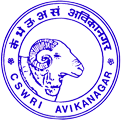BackSUCCESS STORY ON SEQUENTIAL REDUCTION OF ANTHELMINTIC USE FOR WORM MANAGEMENT IN SHEEP FLOCKS OF RAJASTHAN
Gastrointestinal nematode (GIN) infection is a major cause of poor productivity of sheep in the country. Control of GIN is necessary for preventing ill- health and improving productivity. Farmers drench their sheep flocks usually 2-3 times in a year coinciding with shearing schedule. This practice of worm control often resulted in failure of worm control programme, emergence of anthelmintic resistant strain of parasites and increase in the cost of worm control programme.
Based on real time epidemiology of parasites, management (breeding, grazing practices etc) and climatic conditions initially region based worm management programme was formulated for sheep flocks of Rajasthan. The programme includes one strategic drench during mid to late monsoon and one need based tactical drench during autumn/winter. Since 2004, the technology was implemented and demonstrated in farm and field flocks of both arid and semi-arid agro-climatic conditions of Rajasthan covering around 6000 sheep (40 flocks) per annum. The programme saves Rs. 12 / sheep / annum compared to conventional drench schedule without compromising the flock productivity. Comparative evaluation of conventional (CT: 2-3 drench/annum) and targeted treatment (TT: One drench/annum) in sheep naturally infected with GIN at farmer level yielded a net gain of Rs. 100.57 /sheep/yr as direct benefit on application of TT approach compared to CT approach. Further, indirect benefits of technology are reduction in selection pressure on parasites thus delays the emergence of anthelmintic resistance, extend the life of existing anthelmintics.
Further, to increase quantum of refugia and decrease in selection pressure for anthelmintic resistance through harvesting the benefits of over-dispersion in faecal egg count a mechanism was developed. It is a simple system to categorize the anaemic status of sheep based on the conjunctiva mucosa colours on a scale from 1 (red) to 5 (white). Only those sheep fall in group 4 / 5 were recommended for anthelmintic treatment particularly in wormy season. An average of 23% sheep in flock was given drench / annum through TST as against 100% in targeted treatment approach. Direct benefit of TST application in sheep flock resulted in reduction in expenditure on anthelmintics from Rs. 7.0 to Rs. 0.81 / head / yr.
Economic evaluation of different worm management schemes at farm level indicated that in sheep naturally infected with targeted treatment approach (1 drench / yr), there was a net gain of Rs. 176.07 /sheep/yr with compared to conventional treatment approach (>3 drench / yr). Compared to targeted treatment approach, a net gain of Rs. 155.76 / sheep/yr was realized with TST.


